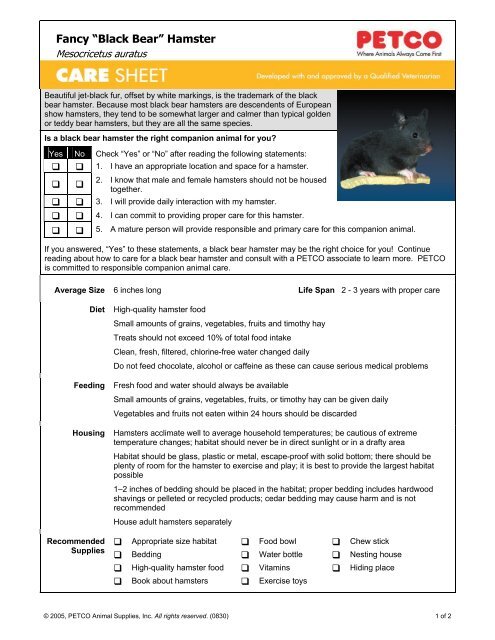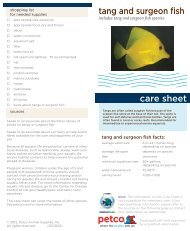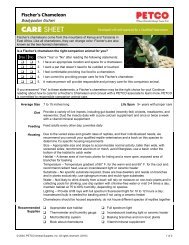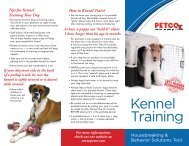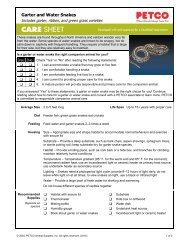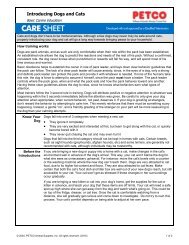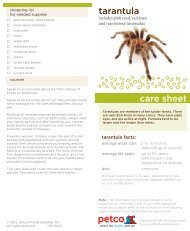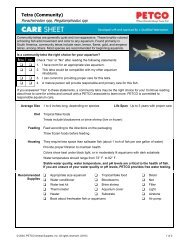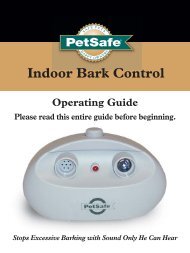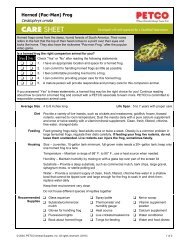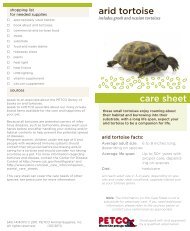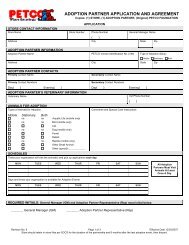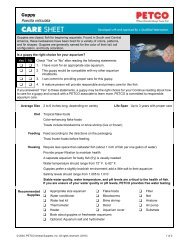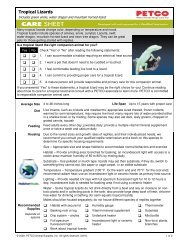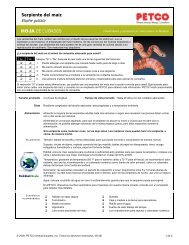Fancy “Black Bear” Hamster - Petco
Fancy “Black Bear” Hamster - Petco
Fancy “Black Bear” Hamster - Petco
You also want an ePaper? Increase the reach of your titles
YUMPU automatically turns print PDFs into web optimized ePapers that Google loves.
<strong>Fancy</strong> <strong>“Black</strong> <strong>Bear”</strong> <strong>Hamster</strong><br />
Mesocricetus auratus<br />
Beautiful jet-black fur, offset by white markings, is the trademark of the black<br />
bear hamster. Because most black bear hamsters are descendents of European<br />
show hamsters, they tend to be somewhat larger and calmer than typical golden<br />
or teddy bear hamsters, but they are all the same species.<br />
Is a black bear hamster the right companion animal for you?<br />
Yes No Check “Yes” or “No” after reading the following statements:<br />
1. I have an appropriate location and space for a hamster.<br />
<br />
If you answered, “Yes” to these statements, a black bear hamster may be the right choice for you! Continue<br />
reading about how to care for a black bear hamster and consult with a PETCO associate to learn more. PETCO<br />
is committed to responsible companion animal care.<br />
Average Size 6 inches long Life Span 2 - 3 years with proper care<br />
Diet High-quality hamster food<br />
Small amounts of grains, vegetables, fruits and timothy hay<br />
Treats should not exceed 10% of total food intake<br />
Clean, fresh, filtered, chlorine-free water changed daily<br />
Do not feed chocolate, alcohol or caffeine as these can cause serious medical problems<br />
Feeding Fresh food and water should always be available<br />
Small amounts of grains, vegetables, fruits, or timothy hay can be given daily<br />
Vegetables and fruits not eaten within 24 hours should be discarded<br />
Housing <strong>Hamster</strong>s acclimate well to average household temperatures; be cautious of extreme<br />
temperature changes; habitat should never be in direct sunlight or in a drafty area<br />
Recommended<br />
Supplies<br />
2. I know that male and female hamsters should not be housed<br />
together.<br />
3. I will provide daily interaction with my hamster.<br />
4. I can commit to providing proper care for this hamster.<br />
5. A mature person will provide responsible and primary care for this companion animal.<br />
Habitat should be glass, plastic or metal, escape-proof with solid bottom; there should be<br />
plenty of room for the hamster to exercise and play; it is best to provide the largest habitat<br />
possible<br />
1–2 inches of bedding should be placed in the habitat; proper bedding includes hardwood<br />
shavings or pelleted or recycled products; cedar bedding may cause harm and is not<br />
recommended<br />
House adult hamsters separately<br />
Appropriate size habitat Food bowl Chew stick<br />
Bedding Water bottle Nesting house<br />
High-quality hamster food Vitamins Hiding place<br />
Book about hamsters Exercise toys<br />
© 2005, PETCO Animal Supplies, Inc. All rights reserved. (0830) 1 of 2
<strong>Fancy</strong> <strong>“Black</strong> <strong>Bear”</strong> <strong>Hamster</strong><br />
Mesocricetus auratus<br />
Normal<br />
Behavior and<br />
Interaction<br />
Habitat<br />
Maintenance<br />
Grooming<br />
and Hygiene<br />
Signs of a<br />
Healthy Animal<br />
Common<br />
Health Issues<br />
Red Flags<br />
Active during the night and sleep during the day (nocturnal)<br />
Easy to handle but may nip if suddenly awakened from a nap or startled<br />
Chews on objects to maintain the incisor teeth, which grow continuously; ensure have plenty<br />
of chew sticks available<br />
Uses cheek pouches to move food from one location to another<br />
Solitary; never house more than one adult hamster per habitat<br />
Remove wet spots daily; change bedding weekly or more often as needed<br />
Clean the habitat and its contents once a week with mild soap and water, rinse and allow to<br />
dry completely before placing hamster back into the habitat<br />
<strong>Hamster</strong>s stay clean and do not need baths; clean with a damp washcloth or unscented baby<br />
wipes, if necessary<br />
Consult with a veterinarian if a hamster’s teeth or nails seem too long<br />
Because all hamsters are potential carriers of infectious diseases, always wash your hands before and<br />
after handling your hamster and/or the habitat contents to help prevent the potential of spread of<br />
diseases.<br />
Pregnant women and people with weakened immune systems should contact their physician before<br />
purchasing and/or caring for a hamster and should consider not having a hamster as a pet. For more<br />
information regarding hamsters and disease, contact the Center for Disease Control at<br />
http://www.cdc.gov/healthypets/ and PETCO at http://www.petco.com/pet care info/companion animal<br />
care sheets.<br />
• Active, alert, and responsive • Eats and drinks regularly<br />
• Healthy, clean fur and clear eyes • Clear breathing and walks normally<br />
It is normal for a hamster’s teeth to be yellow; cleaning is not necessary<br />
Health Issue Symptoms or Causes Suggested Action<br />
Diabetes Frequent urination and lethargy. Consult with an exotic animal<br />
veterinarian.<br />
Diarrhea Loose stools caused by poor diet, stress,<br />
internal parasites, unclean housing, or<br />
other illness.<br />
If you notice any of these signs, please contact your exotic animal veterinarian.<br />
Sources Choosing a Small Mammal by Dennis Kelsey-Wood<br />
<strong>Hamster</strong>s as a New Pet by Anmarie Barrie<br />
The ASPCA Complete Guide to Pet Care by David L. Carroll<br />
Consult with an exotic animal<br />
veterinarian to determine cause<br />
and treatment.<br />
Malocclusion Overgrown teeth. Consult with an exotic animal<br />
veterinarian to possibly have<br />
teeth trimmed regularly.<br />
Mites External parasite that causes hamsters<br />
to lose patches of hair.<br />
Contact an exotic animal<br />
veterinarian for treatment.<br />
• Weight loss • Abnormal hair loss • Diarrhea or dirty bottom<br />
• Distressed breathing • Lethargic • Eye or nasal discharge<br />
• Skin lesions • Overgrown teeth<br />
Note: The information on this Care Sheet is not a substitute for veterinary care. If you need additional<br />
information, please refer to the above sources or contact your veterinarian as appropriate.<br />
2 of 2 SKU 926337© 2005, PETCO Animal Supplies, Inc. All rights reserved. (0830)


